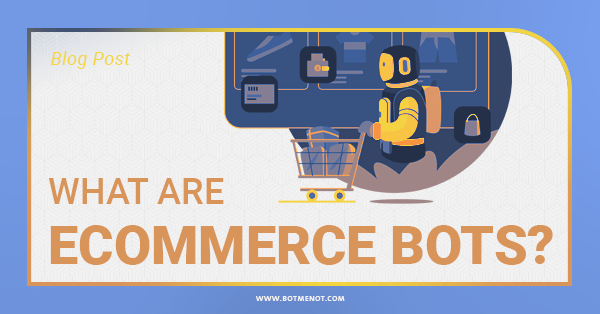
What are eCommerce bots? ECommerce bots are types of bots that are used in all aspects of the eCommerce business. Well-known use cases are customer relationship management, automating purchases, gathering market data, and more.
This is a very broad definition, and we’ll get more specific later on in the article. However, first, let’s briefly cover two very important things. What does “eCommerce” mean, and what are bots in the first place.
According to Wikipedia, eCommerce is “the activity of electronically buying or selling of products on online services or over the Internet”. The world of eCommerce is all about efficiency. Think about its benefits:
- There’s no need to spend time going to a brick-and-mortar store,
- No need to look for working hours,
- No need to avoid store clerks,
- Comparing items is much easier, etc.
With eCommerce bots, efficiency just became even more important. Almost every simple and repetitive task has been automated. Nowadays, it’s crucial to make a customer’s path to purchase on any channel you’re present on as frictionless as possible.
One last thing before we see what types of eCommerce bots there are – what are bots in the first place?
Essentially, an (internet) bot is a software/program that performs automated tasks much faster and with fewer errors than humans can.
Types of eCommerce Bots
There are numerous types of eCommerce bots. There are also numerous types of classifications. In this article, we’ve decided to point out three of the most common types – eCommerce chatbots, scalper bots, and price monitoring bots.

eCommerce Chatbots
A chatbot is essentially a computer program (or to be more technical – a software application) that interacts with website visitors in a specific way. Its interface is usually a chatbox. In that interface, visitors can either freely input their queries or choose from the preselected ones.
Once a visitor inputs something, the chatbot responds. These chatbots usually tend to imitate humans and depending on how advanced they are, they’ll be more or less successful at it. However, there are also exceptions, where chatbots are presented as robots with personalities or any other persona that’s suitable for the website.
So what distinguishes the eCommerce chatbots from the rest? That’s a great question.
In most cases, an eCommerce bot will try to simulate a store clerk who has all the answers to your questions. Furthermore, chatbots are made to be as unintrusive as possible. Also, an intelligent eCommerce bot can learn a lot about website visitors. It can gather information about browsing habits, gather marketing data, and adapt to each customer. This makes the shopping experience much more personalized and enjoyable.
Another use case for this type of bot is customer service. With these bots, and through their interface, users can make different types of inquiries. For example, users can ask about their orders, leave feedback, ask technical questions, and more. Basically, everything that’s not directly related to the purchasing journey can be handled by a customer service chatbot.
Scalper Bots
Scalper bots are also known as purchasing bots or shopping bots. The primary purpose of this type of eCommerce bot is to make a purchase on a website much faster than any human can (and also faster than other bots).
This is possible because making a purchase on basically any website has been standardized. Usually, there are the following steps:
- Browse the site & go to the specific item page
- Depending on if there are product varieties on the same page, select options that suit you
- Click “Add to Cart” or a similar button
- Go to your cart and proceed with the checkout process
- Enter all the necessary information – billing, address, delivery options, etc.
- Click on Purchase (or the corresponding CTA),
That’s more or less the same purchasing structure for every eCommerce website. Whenever there’s such a set of repetitive tasks, there’s a high chance they can be automated and performed by bots. This is exactly what scalper bots do.
There are numerous ways to protect a website from these bots. Truth be told, none of them are bulletproof. Even Google’s (re)CAPTCHA can be bypassed. What’s even more interesting is that some of the websites where these types of bots are most rampant have very low bot protection scores – and that’s a worrying indication. However, this doesn’t mean website owners should stop investing in bot protection. It just means that it’s an ongoing game and that it’s not a one-and-done thing.
Price Monitoring Bots
When it comes to eCommerce bots, people rarely discuss one specific type of bot. However, they bring in an extremely significant value to any business that utilizes them. We’re talking about price monitoring bots. These bots scrape websites for product information such as prices (obviously), seller names, ratings, product assortment & stock status, and more.
This type of eCommerce bot is not always looked upon as a good thing. This is despite the fact they undeniably bring a significant competitive advantage. The issue is that they gather data without the website owner’s approval. On the other hand, that data is already publicly available, and anyone can see it and store it. Using price monitoring bots simply speeds up that process. Furthermore, the issue of the legality of web scraping has already been discussed in front of US courts. The ruling has been made that web scraping is not illegal (at least not in the US).
Final words about eCommerce bots
We’ve seen what eCommerce bots are, what main types exist, and what’s their purpose. We can also conclude that whether we’re going to categorize a bot as “good” or “bad” (in some cases, at least) depends on the use case.
If you’re an eCommerce website owner or an owner of any other type of website, here’s what’s important for you.
Knowing how well protected your website is against different types of bots is crucial. By running an unprotected website you’re placing yourself in a competitive disadvantage – for no reason.
If you want to know how well protected your website is against bot traffic just run a BotMeNot test on it. It’s risk-free, simple to perform, takes less than 7 minutes, and gives you a good starting point when it comes to identifying things you need to work on.
The great thing is that, as BotMeNot is still in the beta stage, using it is completely free, and as a welcoming gift, we’re giving away 100 free testing credits to everyone who registers as a beta user!
